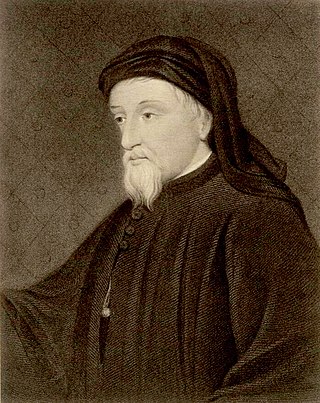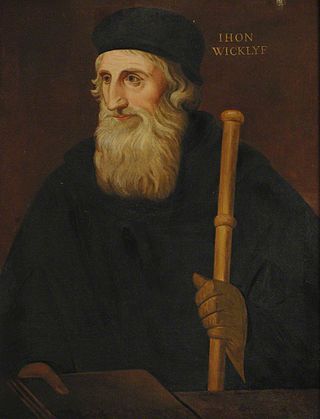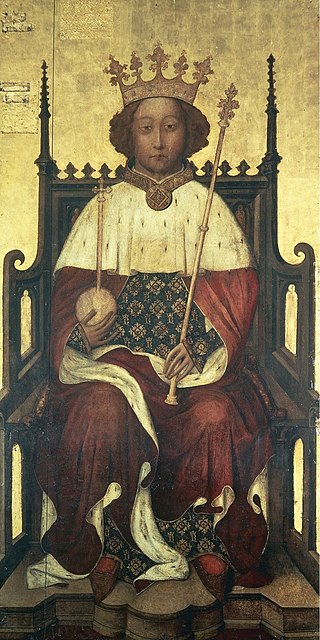
Consubstantiation is a Christian theological doctrine that describes the real presence of Christ in the Eucharist. It holds that during the sacrament, the substance of the body and blood of Christ are present alongside the substance of the bread and wine, which remain present. It was part of the doctrines of Lollardy, and considered a heresy by the Roman Catholic Church. It was later championed by Edward Pusey of the Oxford Movement, and is therefore held by many high church Anglicans.

Geoffrey Chaucer was an English poet, author, and civil servant best known for The Canterbury Tales. He has been called the "father of English literature", or, alternatively, the "father of English poetry". He was the first writer to be buried in what has since come to be called Poets' Corner, in Westminster Abbey. Chaucer also gained fame as a philosopher and astronomer, composing the scientific A Treatise on the Astrolabe for his 10-year-old son Lewis. He maintained a career in the civil service as a bureaucrat, courtier, diplomat, and member of parliament.

John Wycliffe was an English scholastic philosopher, theologian, biblical translator, reformer, Catholic priest, and a seminary professor at the University of Oxford. He became an influential dissident within the Catholic priesthood during the 14th century and is considered an important predecessor to Protestantism. Wycliffe questioned the privileged status of the clergy, who had bolstered their powerful role in England, and the luxury and pomp of local parishes and their ceremonies.

Lollardy, also known as Lollardism or the Lollard movement, was a proto-Protestant Christian religious movement that existed from the mid-14th century until the 16th-century English Reformation. It was initially led by John Wycliffe, a Catholic theologian who was dismissed from the University of Oxford in 1381 for criticism of the Roman Catholic Church. The Lollards' demands were primarily for reform of Western Christianity. They formulated their beliefs in the Twelve Conclusions of the Lollards.

Richard II, also known as Richard of Bordeaux, was King of England from 1377 until he was deposed in 1399. He was the son of Edward the Black Prince, Prince of Wales, and Joan, Countess of Kent. Richard's father died in 1376, leaving Richard as heir apparent to his grandfather, King Edward III; upon the latter's death, the 10-year-old Richard succeeded to the throne.

The House of Lancaster was a cadet branch of the royal House of Plantagenet. The first house was created when King Henry III of England created the Earldom of Lancaster—from which the house was named—for his second son Edmund Crouchback in 1267. Edmund had already been created Earl of Leicester in 1265 and was granted the lands and privileges of Simon de Montfort, 6th Earl of Leicester, after de Montfort's death and attainder at the end of the Second Barons' War. When Edmund's son Thomas, 2nd Earl of Lancaster, inherited his father-in-law's estates and title of Earl of Lincoln he became at a stroke the most powerful nobleman in England, with lands throughout the kingdom and the ability to raise vast private armies to wield power at national and local levels. This brought him—and Henry, his younger brother—into conflict with their cousin King Edward II, leading to Thomas's execution. Henry inherited Thomas's titles and he and his son, who was also called Henry, gave loyal service to Edward's son King Edward III.
Margery Kempe was an English Christian mystic, known for writing through dictation The Book of Margery Kempe, a work considered by some to be the first autobiography in the English language. Her book chronicles Kempe's domestic tribulations, her extensive pilgrimages to holy sites in Europe and the Holy Land, as well as her mystical conversations with God. She is honoured in the Anglican Communion, but has not been canonised as a Catholic saint.
John Purvey was an English theologian, reformer, and disciple of John Wycliffe. He was born around 1354 in Lathbury, near Newport Pagnell in the county of Buckinghamshire, England. He was a great scholar, permitted to enter all priestly ranks on 13 March 1377, or 1378. It has been assumed by scholars that Purvey became acquainted with Wycliffe's ideas in Oxford. In around 1382, Purvey lived with Wycliffe at Lutterworth, Leicestershire, along with Nicholas of Hereford and John Aston, and became one of Wycliffe's disciples.

Pierce the Ploughman's Crede is a medieval alliterative poem of 855 lines, lampooning the four orders of friars.

Sir John Clanvowe was a Welsh diplomat, poet and chamber knight to Richard II. He was born to a Marcher family and was possibly of mixed Anglo-Welsh origin, holding lands that would lie in the present-day Radnorshire district of Powys and in Herefordshire.
Richard Hunne was an English merchant tailor in the City of London during the early years of the reign of Henry VIII (1509-1547). After a dispute with his priest over his infant son's funeral, Hunne sought to use the English common law courts to challenge the church's authority. In response, church officials arrested him for trial in an ecclesiastical court on the capital charge of heresy.

Sir Richard Southwell PC was an English Privy Councillor.
The Piers Plowman tradition is made up of about 14 different poetic and prose works from about the time of John Ball and the Peasants Revolt of 1381 through the reign of Elizabeth I and beyond. All the works feature one or more characters, typically Piers, from William Langland's poem Piers Plowman. Because the Plowman appears in the General Prologue to The Canterbury Tales by Geoffrey Chaucer but does not have his own tale, plowman tales are sometimes used as additions to The Canterbury Tales, or otherwise conflated or associated with Chaucer.

Eleanor Cobham was an English noblewoman, first the mistress and then the second wife of Humphrey, Duke of Gloucester, who in 1441 was forcibly divorced and sentenced to life imprisonment for treasonable necromancy, a punishment likely to have been politically motivated.

John Rykener, also known as Eleanor, was a 14th-century sex worker arrested in December 1394 for performing a sex act with John Britby, a man who was a former chaplain of the St Margaret Pattens church, in London's Cheapside while wearing female attire. Although historians tentatively link Rykener to a prisoner of the same name, the only known facts of the sex worker's life come from an interrogation made by the mayor of London. Rykener was questioned on two offences: prostitution and sodomy. Prostitutes were not usually arrested in London during this period, while sodomy was an offence against morality rather than common law, and so pursued in ecclesiastical courts. There is no evidence that Rykener was prosecuted for either crime.
John Lutterell was an English medieval philosopher, theologian, and university chancellor.
Margery Baxter was an outspoken and unorthodox Lollard from Martham, England. She was brought to trial twice and flogged at church.
Isobel Dorothy Thornley FRHS FSA was a British historian of medieval England who compiled and edited works on legal history, the Yorkists, Richard II, and medieval sanctuary. She was a lecturer at University College London and later an independent scholar editing medieval law reports. She died when her home was hit by a bomb during the London Blitz. She left money to the University of London who award grants from her bequest for the publication of books that would not otherwise be published and to support candidates registered for a PhD at the university.
Elizabeth Kirkeby was a 15th-century English goldsmith and merchant.
Hawise Mone was an English Lollard in Norfolk in the fifteenth century. She was brought to trial after arranging meetings that had included the heretic William White who was burnt at the stake in 1428.









